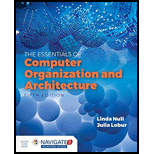
a)
Explanation of Solution
Converting “110001.10101” to decimal equivalent:
Step 1: First separate the given binary fractions into two parts, left binary part and right binary fractions.
Step 2: To convert the binary fraction into decimal number, multiply the left part of the binary number with the positive integers for base 2.
Step 3: Multiply the right part of the binary number with the negative integers for base 2.
Step 4: Add all the values to get the final result.
Thus, the decimal equivalent of 10001.10101 is “
b)
Explanation of Solution
Converting “111001.001011” to decimal equivalent:
Step 1: First separate the given binary fractions into two parts, left binary part and right binary fractions.
Step 2: To convert the binary fraction into decimal number, multiply the left part of the binary number with the positive integers for base 2.
Step 3: Multiply the right part of the binary number with the negative integers for base 2.
Step 4: Add all the values to get the final result.
Thus, the decimal equivalent of 111001.001011 is “
c)
Explanation of Solution
Converting “1001001.10101” to decimal equivalent:
Step 1: First separate the given binary fractions into two parts, left binary part and right binary fractions.
Step 2: To convert the binary fraction into decimal number, multiply the left part of the binary number with the positive integers for base 2.
Step 3: Multiply the right part of the binary number with the negative integers for base 2.
Step 4: Add all the values to get the final result.
Thus, the decimal equivalent of 1001001.10101 is “
d)
Explanation of Solution
Converting “11101001.110001” to decimal equivalent:
Step 1: First separate the given binary fractions into two parts, left binary part and right binary fractions.
Step 2: To convert the binary fraction into decimal number, multiply the left part of the binary number with the positive integers for base 2.
Step 3: Multiply the right part of the binary number with the negative integers for base 2.
Step 4: Add all the values to get the final result.
Thus, the decimal equivalent of 11101001.110001 is “
Want to see more full solutions like this?
Chapter 2 Solutions
Essentials of Computer Organization and Architecture
 Database System ConceptsComputer ScienceISBN:9780078022159Author:Abraham Silberschatz Professor, Henry F. Korth, S. SudarshanPublisher:McGraw-Hill Education
Database System ConceptsComputer ScienceISBN:9780078022159Author:Abraham Silberschatz Professor, Henry F. Korth, S. SudarshanPublisher:McGraw-Hill Education Starting Out with Python (4th Edition)Computer ScienceISBN:9780134444321Author:Tony GaddisPublisher:PEARSON
Starting Out with Python (4th Edition)Computer ScienceISBN:9780134444321Author:Tony GaddisPublisher:PEARSON Digital Fundamentals (11th Edition)Computer ScienceISBN:9780132737968Author:Thomas L. FloydPublisher:PEARSON
Digital Fundamentals (11th Edition)Computer ScienceISBN:9780132737968Author:Thomas L. FloydPublisher:PEARSON C How to Program (8th Edition)Computer ScienceISBN:9780133976892Author:Paul J. Deitel, Harvey DeitelPublisher:PEARSON
C How to Program (8th Edition)Computer ScienceISBN:9780133976892Author:Paul J. Deitel, Harvey DeitelPublisher:PEARSON Database Systems: Design, Implementation, & Manag...Computer ScienceISBN:9781337627900Author:Carlos Coronel, Steven MorrisPublisher:Cengage Learning
Database Systems: Design, Implementation, & Manag...Computer ScienceISBN:9781337627900Author:Carlos Coronel, Steven MorrisPublisher:Cengage Learning Programmable Logic ControllersComputer ScienceISBN:9780073373843Author:Frank D. PetruzellaPublisher:McGraw-Hill Education
Programmable Logic ControllersComputer ScienceISBN:9780073373843Author:Frank D. PetruzellaPublisher:McGraw-Hill Education





